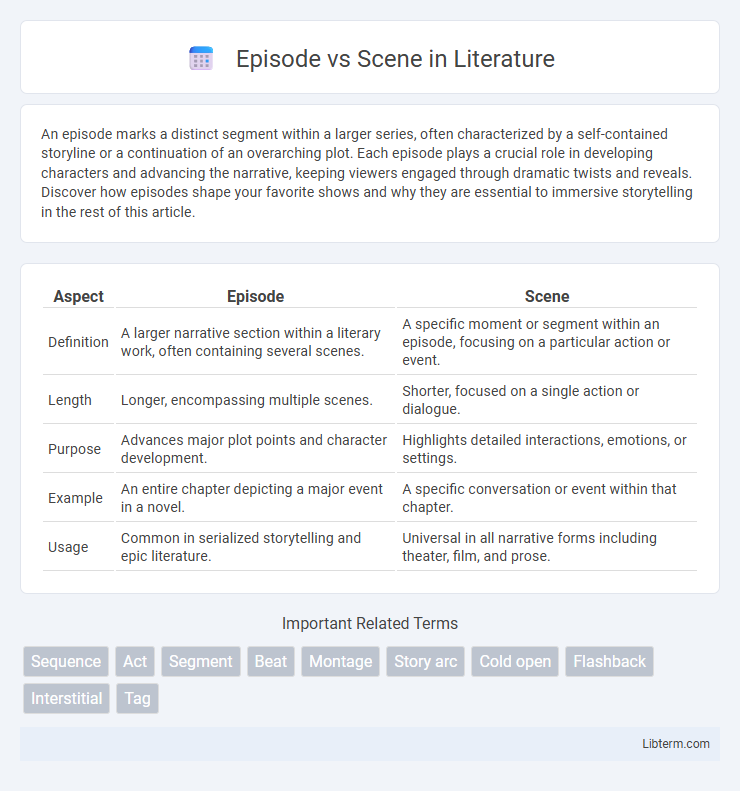An episode marks a distinct segment within a larger series, often characterized by a self-contained storyline or a continuation of an overarching plot. Each episode plays a crucial role in developing characters and advancing the narrative, keeping viewers engaged through dramatic twists and reveals. Discover how episodes shape your favorite shows and why they are essential to immersive storytelling in the rest of this article.
Table of Comparison
| Aspect | Episode | Scene |
|---|---|---|
| Definition | A larger narrative section within a literary work, often containing several scenes. | A specific moment or segment within an episode, focusing on a particular action or event. |
| Length | Longer, encompassing multiple scenes. | Shorter, focused on a single action or dialogue. |
| Purpose | Advances major plot points and character development. | Highlights detailed interactions, emotions, or settings. |
| Example | An entire chapter depicting a major event in a novel. | A specific conversation or event within that chapter. |
| Usage | Common in serialized storytelling and epic literature. | Universal in all narrative forms including theater, film, and prose. |
Defining Episode and Scene
An episode is a distinct segment of a television series or narrative, typically containing a self-contained story or a part of a larger story arc, lasting from 20 to 60 minutes. A scene is a smaller component within an episode or film, representing a continuous action or interaction in a specific location or time, often lasting a few minutes. The episode serves as the broader structural unit, while scenes build the narrative step-by-step through dialogue, character development, and plot advancement.
Key Differences Between Episodes and Scenes
Episodes represent larger narrative units in TV shows or series, encompassing multiple scenes that contribute to an overarching plot or theme. Scenes are smaller, focused segments within an episode that capture specific moments, actions, or dialogues at a single location and time. Key differences include scope, with episodes spanning broader story arcs, while scenes provide detailed context and progression within those arcs.
The Role of Episodes in Story Structure
Episodes serve as major narrative units that organize a story into distinct segments, each with its own mini-arc and contributing to the overall plot progression. They enable the pacing of complex stories by grouping related scenes, facilitating character development and thematic exploration within a coherent framework. By structuring the story into episodes, writers can create clear turning points and build suspense, enhancing audience engagement throughout the narrative.
The Function of Scenes in Narrative Flow
Scenes serve as the fundamental structural units in narrative flow, driving the plot by showcasing specific actions, emotions, and interactions that build tension and develop characters. Each scene strategically shifts the story forward, creating momentum and maintaining audience engagement through focused, moment-to-moment events. These narrative building blocks collectively form episodes, which encapsulate broader story arcs and thematic complexity.
How Episodes Shape a Series
Episodes serve as the fundamental structural units in a television series, each crafted to advance overarching storylines, develop characters, and establish thematic consistency. By weaving individual episodes into a cohesive narrative arc, creators can build suspense, deepen audience engagement, and enhance viewer retention across seasons. Effective episode construction strategically balances plot progression and character moments, shaping the series' tone and emotional impact.
How Scenes Drive the Plot
Scenes serve as the building blocks within episodes, each encapsulating specific actions and interactions that propel the narrative forward. By focusing on key moments, scenes create tension, reveal character motivations, and introduce conflicts that advance the plot. Effective scene construction ensures pacing and emotional engagement, making the overall episode cohesive and compelling.
Episode vs Scene: Practical Examples
An episode in a TV series typically consists of multiple scenes that together form a complete segment of the storyline, such as a 45-minute episode of "Friends" made up of several coffee shop, apartment, and office scenes. A scene is a smaller unit within an episode, representing a continuous action or dialogue in a single location and timeframe, like a conversation between characters in Monica's apartment in "Friends" Season 3, Episode 5. Practical examples highlight that episodes provide the overall narrative progression, while scenes are individual building blocks that develop specific moments and character interactions.
Tips for Writing Effective Episodes
Effective episodes in storytelling should have a clear objective, driving the overall plot development while maintaining audience engagement through emotional stakes and character growth. Each episode combines multiple scenes that build tension, reveal conflicts, and advance subplots, ensuring a dynamic narrative flow. Writers should focus on pacing, cohesive transitions, and thematic consistency to create memorable and impactful episodes.
Crafting Engaging Scenes
Crafting engaging scenes requires focusing on vivid sensory details and dynamic character interactions to immerse the audience effectively. Each scene should reveal plot development or character motivation, maintaining narrative momentum within the broader episode structure. Utilizing concise dialogue and purposeful action enhances emotional impact, making scenes memorable and driving the story forward.
Common Mistakes: Episode and Scene Confusion
A common mistake in film and television writing is confusing an episode with a scene, where an episode is a complete segment of a series, typically lasting 20 to 60 minutes, while a scene is a smaller unit within an episode, defined by continuous time and location. Writers often mistakenly treat scenes as standalone narratives, overlooking that scenes collectively build the episode's overall plot and pacing. Understanding this hierarchy is crucial for clear storytelling and proper script structure in episodic content.
Episode Infographic

 libterm.com
libterm.com